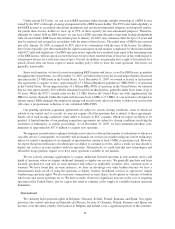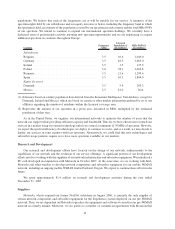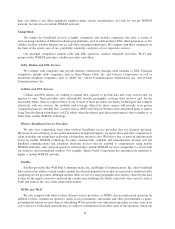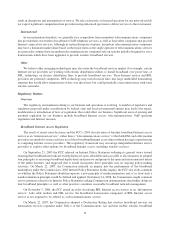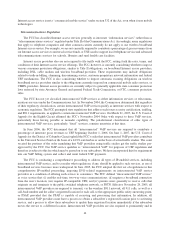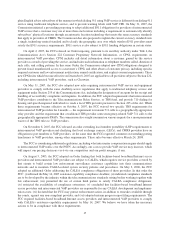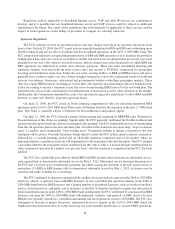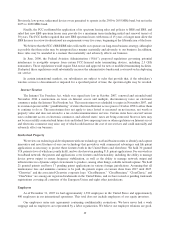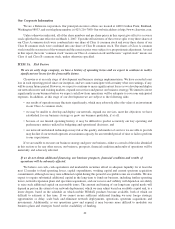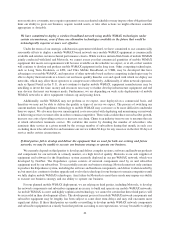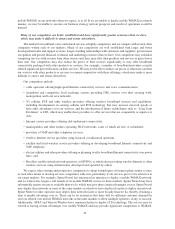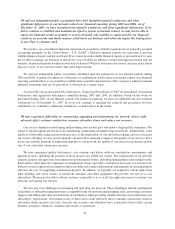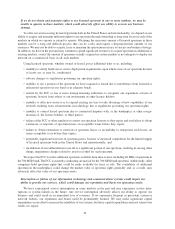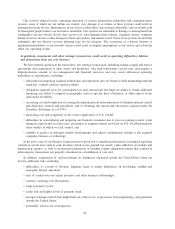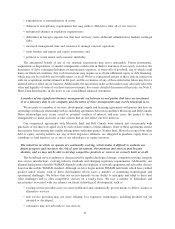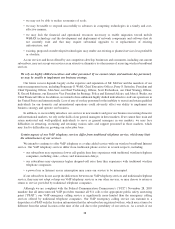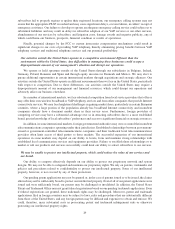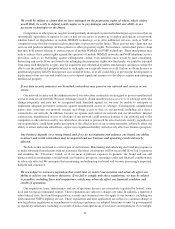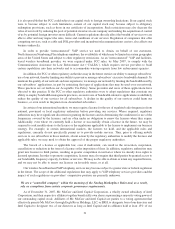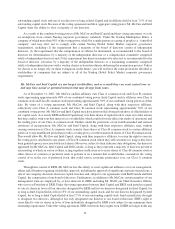Clearwire 2007 Annual Report Download - page 30
Download and view the complete annual report
Please find page 30 of the 2007 Clearwire annual report below. You can navigate through the pages in the report by either clicking on the pages listed below, or by using the keyword search tool below to find specific information within the annual report.more restrictive covenants, may require repayment on an accelerated schedule or may impose other obligations that
limit our ability to grow our business, acquire needed assets, or take other actions we might otherwise consider
appropriate or desirable.
We have committed to deploy a wireless broadband network using mobile WiMAX technologies under
certain circumstances, even if there are alternative technologies available in the future that would be
technologically superior or more cost effective.
Under the terms of our strategic collaboration agreement with Intel, we have committed to use commercially
reasonable efforts to deploy a mobile WiMAX based network once mobile WiMAX equipment is commercially
available and satisfies certain technical performance criteria. While we have initiated field trials of mobile WiMAX
jointly conducted with Intel and Motorola, we cannot assure you that commercial quantities of mobile WiMAX
equipment that meets our requirements will become available on the schedule we expect, or at all, or that vendors
will continue to develop and produce mobile WiMAX equipment in the long term. Other competing technologies,
such as Long Term Evolution, or LTE, and Ultra Mobile Broadband, or UMB, may be developed that have
advantages over mobile WiMAX, and operators of other networks based on those competing technologies may be
able to deploy their networks at a lower cost and more quickly than the cost and speed with which we deploy our
networks, which may allow those operators to compete more effectively. Additionally, if other network operators,
such as Sprint Nextel in the U.S., do not continue to deploy mobile WiMAX, equipment manufacturers may be
unwilling to invest the time, money and resources necessary to further develop infrastructure equipment and end
user devices that meet our business needs. Furthermore, we are depending on wide scale deployments of mobile
WiMAX networks to drive equipment volumes up and pricing down.
Additionally, mobile WiMAX may not perform as we expect, once deployed on a commercial basis, and
therefore we may not be able to deliver the quality or types of service we expect. The process of switching our
current markets from Expedience technology to mobile WiMAX may cost more or be more difficult to undertake
than we expect. We also may discover unanticipated costs associated with deploying and maintaining our network
or delivering services we must offer in order to remain competitive. These risks could reduce our subscriber growth,
increase our costs of providing services or increase our churn. Churn is an industry term we use to measure the rate
at which subscribers terminate service. We calculate this metric by dividing the number of subscribers who
terminate their service in a given month by the average number of subscribers during that month, in each case
excluding those who subscribe for and terminate our service within 30 days for any reason or in the first 90 days of
service under certain circumstances.
If third parties fail to develop and deliver the equipment that we need for both our existing and future
networks, we may be unable to execute our business strategy or operate our business.
We currently depend on third parties to develop and deliver complex systems, software and hardware products
and components for our network in a timely manner, at a high level of quality. Motorola is our sole supplier of
equipment and software for the Expedience system currently deployed in our pre-WiMAX network, which was
developed by NextNet. The Expedience system consists of network components used by us and subscriber
equipment used by our subscribers. To successfully execute our business strategy, Motorola must not only continue
to produce the Expedience system, including the software and hardware components, and deliver it when needed by
us, but must also continue to further upgrade and evolve the technology for our business to remain competitive until
we fully deploy mobile WiMAX technologies. Any failure by Motorola to meet these needs may impair our ability
to execute our business strategy and our ability to operate our business.
For our planned mobile WiMAX deployment, we are relying on third parties, including Motorola, to develop
the network components and subscriber equipment necessary to build and operate our mobile WiMAX networks.
As mobile WiMAX is a new and highly sophisticated technology, we cannot be certain that these third parties will
be successful in their development efforts. The development process for mobile WiMAX network components and
subscriber equipment may be lengthy, has been subject to some short term delays and may still encounter more
significant delays. If these third parties are unable or unwilling to develop mobile WiMAX network components
and subscriber equipment on a timely basis that perform according to our expectations, we may be unable to deploy
22


